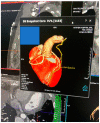Safety and Efficacy of PCSK9 Inhibitors in Patients with Acute Coronary Syndrome Who Underwent Coronary Artery Bypass Grafts: A Comparative Retrospective Analysis
- PMID: 38337601
- PMCID: PMC10856256
- DOI: 10.3390/jcm13030907
Safety and Efficacy of PCSK9 Inhibitors in Patients with Acute Coronary Syndrome Who Underwent Coronary Artery Bypass Grafts: A Comparative Retrospective Analysis
Abstract
Background. The in-hospital reduction in low-density lipoprotein cholesterol (LDL-C) levels following acute coronary syndrome (ACS) is recommended in the current clinical guidelines. However, the efficacy of proprotein convertase subtilisin-kexin type 9 (PCSK9) inhibitors in those patients undergoing coronary artery bypass graft (CABG) has never been demonstrated. Methods. From January 2022 to July 2023, we retrospectively analyzed 74 ACS patients characterized by higher LDL-C levels than guideline targets and who underwent coronary bypass surgery. In the first period (January 2022-January 2023), the patients increased their statin dosage and/or added Ezetimibe (Group STEZE, 43 patients). At a later time (February 2023-July 2023), the patients received not only statins and Ezetimibe but also Evolocumab 140 mg every 2 weeks starting as early as possible (Group STEVO, 31 patients). After one and three months post-discharge, the patients underwent clinical and laboratory controls with an evaluation of the efficacy lipid measurements and every adverse event. Results. The two groups did not differ in terms of preoperative risk factors and Euroscore II (STEVO: 2.14 ± 0.75 vs. STEZE: 2.05 ± 0.6, p = 0.29). Also, there was no difference between the groups in terms of ACS (ST-, Instable angina, or NSTE) and time of symptoms onset regarding total cholesterol, LDL-C, and HDL-C trends from the preprocedural period to 3-month follow-up, but there was a more significant reduction in LDL-C and total cholesterol in the STEVO group (p = 0.01 and p = 0.04, respectively) and no difference in HDL-C rise (p = 0.12). No deaths were reported. In three STEZE group patients, angina recurrence posed the need for percutaneous re-revascularization. No STEVO patients developed significant adverse events. The statistical difference in these serious events, 7% in STEZE vs. 0% in STEVO, was not significant (p = 0.26). Conclusions. Evolocumab initiated "as soon as possible" in ACS patients submitted to CABG with high-intensity statin therapy and Ezetimibe was well tolerated and resulted in a substantial and significant reduction in LDL-C levels at discharge, 1 month, and 3 months. This result is associated with a reduction but without a statistical difference between groups.
Keywords: acute coronary syndrome; evolocumab; revascularization; statin.
Conflict of interest statement
The authors declare no conflict of interest.
Figures
References
-
- Baigent C., Blackwell L., Emberson J., Holland L.E., Reith C., Bhala N., Peto R., Barnes E.H., Keech A., Simes J., et al. Efficacy and safety of more intensive lowering of LDL cholesterol: Meta-analysis of data from 170,000 participants in 26 randomised trials. Lancet. 2010;376:1670–1681. - PMC - PubMed
-
- Koskinas K.C., Siontis G.C.M., Piccolo R., Mavridis D., Räber L., Mach F., Windecker S. Effect of statins and nonstatin LDL-lowering medications on cardiovascular outcomes in secondary prevention: A meta-analysis of randomized trials. Eur. Heart J. 2018;39:1172–1180. doi: 10.1093/eurheartj/ehx566. - DOI - PubMed
-
- Ray K.K., Cannon C.P., McCabe C.H., Cairns R., Tonkin A.M., Sacks F.M., Jackson G., Braunwald E. Early and late benefits of high-dose atorvastatin in patients with acute coronary syndromes: Results from the PROVE IT-TIMI 22 trial. J. Am. Coll. Cardiol. 2005;46:1405–1410. doi: 10.1016/j.jacc.2005.03.077. - DOI - PubMed
-
- Roffi M., Patrono C., Collet J.P., Mueller C., Valgimigli M., Andreotti F., Bax J.J., Borger M.A., Brotons C., Chew D.P., et al. 2015 ESC guidelines for the management of acute coronary syndromes in patients presenting without persistent ST-segment elevation: Task Force for the Management of Acute Coronary Syndromes in Patients Presenting without Persistent ST-Segment Elevation of the European Society of Cardiology (ESC) Eur. Heart J. 2016;37:267–315. - PubMed
LinkOut - more resources
Full Text Sources
Medical
Miscellaneous



